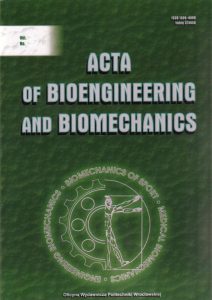Publications

Influence of dopaminergic treatment on resting elbow joint angle control mechanisms in patients with Parkinson’s disease – a preliminary report
Authors: Jarosław Marusiak 1, Anna Jaskólska 1, Sławomir Budrewicz 2, Magdalena Koszewicz 2, Renata Andrzejewska 1, Katarzyna Kisiel-Sajewicz 1, Artur Jaskólski 1
Affiliations:
- Department of Kinesiology, Faculty of Physiotherapy, University School of Physical Education, Wrocław, Poland
- Department of Neurology, Medical University of Wrocław, Wrocław, Poland
Journal: Acta of Bioengineering and Biomechanics - Volume 20, No.4, 75-82 (DOI: 10.5277/ ABB-01224-2018-01)
-
Field & Applications:
- Medical
- Neurology
- Neurodegenerative disorder
- Treatment evaluation
Purpose: Heightened tonic stretch reflex contributes to increased muscle tone and a more-flexed resting elbow joint angle (EJA) in patients with Parkinson’s disease (PD). Dopaminergic medication restores central nervous system (CNS) functioning and decreases resting muscle electrical and mechanical activities. This study aimed to evaluate the effects of dopaminergic medication on parkinsonian rigidity, resting EJA, resting electrical activity (electromyography, EMG) and mechanical properties (myotonometry, MYO) of elbow flexor muscles and the associations of EJA with these muscles resting electrical activity and mechanical properties in PD patients. We also evaluated a relationship between dopaminergic treatment dose and these outcome measures values.
Methods: Ten PD patients (age 68 ± 10.1 years; body mass 70 ± 16.8 kg; height 162 ± 6.6 cm; illness duration 9 ± 4.5 years) were tested during medication on- and off-phases. Resting EJA, myotonometric muscle stiffness (S-MYO) and root mean square electromyogram amplitude (RMS-EMG) were recorded from relaxed biceps brachii and brachioradialis muscles. Based on the above parameters, we also calculated the EJA/S-MYO ratio and EJA/RMS-EMG ratio. Parkinsonian rigidity was assessed using the motor section of the Unified Parkinson’s Disease Rating Scale.
Results: EJA, EJA/S-MYO ratio, and EJA/RMS-EMG ratio were increased and S-MYO, RMS-EMG, and parkinsonian rigidity were decreased during the medication on-phase compared with the off-phase. In addition, the dopaminergic treatment dose was negatively correlated with S-MYO and RMS-EMG, and positively correlated with EJA/SMYO and EJA/RMS-EMG ratios.
Conclusions: We conclude that dopaminergic medication- induced improvements in resting elbow joint angle in tested patients with PD are related to changes in their muscle electrical and mechanical properties.
Keywords: Parkinson’s disease, electromyography, myotonometry, motor control, joint angle, medication
Our findings indicate that an anti-parkinsonian dopaminergic medication improves resting elbow joint angle in patients with PD, and that this improvement is related to changes in the electrical and mechanical properties of elbow flexor muscles.


